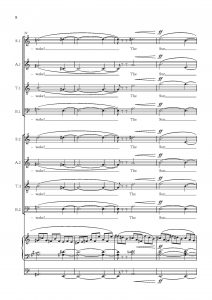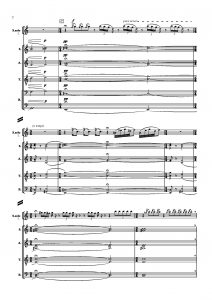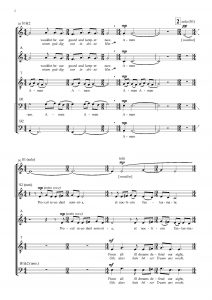Graham Lack
compositor
(Imagen de arriba reproducida con la amable autorización del Capítulo de la Catedral de Wells)
Resumen
La primera parte de este artículo proporcionó una breve historia de la más temprana polifonía vocal empleada en la Iglesia Occidental, desde el órganum hasta las obras de John Dunstaple inclusive, trató sobre el surgimiento de la imitación y el contrapunto, y demostró cómo ese pasado puede actuar como un freno para la continuación y el desarrollo de la música coral de nuestros tiempos. A medida que progresa el siglo XXI, un gran número de compositores eminentes de música coral continúa escribiendo en una vena claramente polifónica, y varios exponentes más jóvenes del arte del contrapunto han pasado al primer plano. Siempre ha existido una clara distinción entre polifonía y contrapunto: todo contrapunto es polifónico, pero no toda la polifonía es contrapuntística. La parte dos del artículo examina obras corales escritas por los compositores británicos John McCabe, David Mathews, Alec Roth y Judith Weir. A falta de un criterio más estricto, se trata a estas figuras prominentes según el orden de sus fechas de nacimiento, con la esperanza de que, no obstante algunas tendencias pronunciadas, se puedan discernir. Todas las clases de afinación son proporcionadas en Helmholtz.
Rara vez se engendra una sensación de excitación, querido lector, cuando el término metodología analítica es encontrado en el comienzo. No obstante, persevera, sé resuelto y reflexiona un poco sobre lo que sigue aquí. Para comprender mejor el papel de las voces y las partes vocales dentro de lo que hemos llamado la Nueva Polifonía en la música coral contemporánea, se han extrapolado varias técnicas de composición establecidas como parámetros con los que medir exactamente lo que está sucediendo dentro de una partitura en particular. Estas herramientas son mejores si las enunciamos como una simple lista, y son las siguientes: tensión y liberación que surgen de las técnicas de suspensión, motivos reconocibles, variación motívica, contornos melódicamente valiosos, el papel de la conducción de voces, significado elíptico, armonía diádica y triádica, armonía de nota errónea, tratamiento de la disonancia (jerarquía de la disonancia, disonancia para evitar la monotonía, semi-disonancia, disonancia sinfónica ecléctica), exploración tímbrica, enfoques contrapuntísticos versus homofónicos, canon y heterofonía, imitación tanto libre como estricta, homenaje y pastiche, formaciones de acordes en bloque para teclado, la nueva simplicidad y desincronización del texto. Ahora, no hay necesidad de rechazar un término u otro, la mayoría de estas categorías son bien conocidas, o se explican por sí mismas, o ambas. En cuanto a las acuñaciones con las que uno aún no está familiarizado, se vuelven claras en el contexto del discurso a continuación. Ahora sigue leyendo…
Si alguna vez hubo una obra que demuestre en el contexto actual hasta qué punto los compositores escriben música sobre música, sería la Natividad de Cristo de John McCabe (1939-2015) para doble coro SATB y órgano. Aquí vislumbramos inmediata y exactamente lo que distingue al compositor de muchos contemporáneos: un lenguaje musical tonal y hasta cierto punto serial, pero que sigue siendo lírico en su constructivismo declarado. El compositor describe cómo había “pasado un tiempo considerable escuchando mucha música temprana de la Iglesia inglesa” y menciona como sus mentores, por así decirlo, a William Byrd, Thomas Tallis, Christopher Tye y Robert Whyte, y agrega que esto bien puede haber influido en la “textura de la música, en particular los aspectos contrapuntísticos”.
John McCabe fue un compositor de obras de muchas formas, un pianista virtuoso, escritor y ex director del London College of Music. Se formó como músico en la Universidad de Manchester, el “antiguo” Royal Manchester College of Music, donde estuvo en la generación universitaria que siguió a la de Birtwistle, Goehr, Ogdon y Maxwell Davies, y en la Hochschule für Musik und Theatre de Munich. Al principio, era obvio que se trataba de un compositor en contacto con las principales tendencias de la música del siglo XX que incluían el jazz, pero que no estaba hechizado por las modas de vanguardia.
En la Natividad de Cristo, McCabe toma dos poemas de Henry Vaughan que describen la gloria de Jesús y su efecto en el reino mortal; el compositor no tiene reparos en utilizar contrastes audaces y dramáticos para lograr efectos polifónicos directos, como los acordes en bloque fortissimo en “The Sun”, en el compás 34 y, en los compases 35-37, los dosillos de corchea en un 9/8 prevaleciente en “doth shake”, un ejemplo notable de pintura de palabras digna de Handel.

Christ’s Nativity — Música de John McCabe — Texto de Henry Vaughan © Copyright 2014 Novello & Co Limited
Derechos reservados. Copyright internacional asegurado — Reproducido con autorización de Novello & Co Limited
El tratamiento de la disonancia es jerárquico; el segundo acorde en el compás 31 (al “-wake” de “awake”) superpone cuartas perfectas Sol sostenido — Do sostenido’- Fa sostenido’ en el bajo Mi, entendiéndose el Re sostenido’ ‘ añadido en la soprano a modo de elipsis como una cuarta perfecta más baja que cualquier Sol sostenido’ implícito; la octava simple La — La’ en “The” -compás 33- encuadra una cuarta perfecta y una quinta perfecta, el Re sostenido’’ cambiando su función para convertirse en una cuarta aumentada de modo lidio contra el bajo; en “Sun”, en el siguiente compás, la armonía pura de Mi menor tiene una intención sinfónica y actúa como un contraste de los acordes mixtos anteriores.
La respuesta compositiva, entonces, a la imaginería mágica de las palabras de Vaughan muestra un sentido de inmediatez y asegura que esta obra de 12 minutos resuene en la mente del público durante un tiempo. Como señala David Lindley en la edición de septiembre de 2015 de Organists ’Review, “el lenguaje armónico es… astringente, las líneas vocales a menudo rítmicamente complejas y melódicamente angulares”. En cuanto al órgano, proporciona un comentario propio y realza la actividad contrapuntística al resaltar esos dosillos en las voces con un implacable brocado de corcheas compuestas. La Natividad de Cristo fue un encargo del Coro Hallé y se estrenó en 2014 en Hallé St Peters con la dirección de Madeleine Venner.
Para los lectores no familiarizados con la música coral de David Matthews (* 1943), algunos hechos simples pondrán su música en perspectiva. Trabajó desde mediados de la década de 1960 como aprendiz en el estudio de Benjamin Britten, y se benefició de una formación invaluable, aunque no se sintió lo suficientemente audaz como para mostrarle su propia música. Britten no enseñaba, y tampoco lo hacía el “verdadero héroe en ese momento” de Matthews, Michael Tippett, quien al menos recomendó como maestro a un compositor más joven, Anthony Milner. Posteriormente Matthews estudió con Nicholas Maw, cuya música también admiraba mucho, y explica cómo empezó a ganar la confianza para escribir como quería en lugar de sentir que debía “intentar componer como Boulez o Stockhausen, que dominaban la escena musical en el tiempo”, añadiendo que no se sentía “destinado a seguir las vanguardias actuales, sino a continuar por un camino similar al que iban siguiendo Britten y Tippett, también arraigado en los clásicos vieneses, Mahler y los modernistas de principios del siglo XX: Stravinsky, Schönberg, Berg y Bartók”. Matthews, entonces, siempre había sabido que nunca debía abandonar la tonalidad, sino intentar reconciliar el presente con el pasado. Su música y sus obras corales en particular, se moldean en formas tradicionales maduras, el lenguaje musical está maduro pero aún sin comenzar a pudrirse. Siempre ha mantenido un firme compromiso con una música basada en el canto y la danza, y conectada con la lengua vernácula.Un buen ejemplo de esto es su The Key of the Kingdom, una composición basada en la canción infantil anónima ‘This is the Key of the Kingdom’ para coro SATB con órgano ad libitum y el primer poema de la antología para niños de Walter de la Mare llamado Come Hither. Este es, de hecho, un verso misterioso, y actúa como una especie de hechizo, o mandala, sus líneas acumulativas conducen gradualmente a un descubrimiento en el medio de un momento de quietud, antes de que el hechizo vuelva atrás. Matthew se entrega aquí a pesados bloques de polifonía, tomados en el sentido de muchos sonidos en oposición a las muchas voces más literales per se, marcando una métrica sencilla de 4/4 con tresillos de negra ascendentes en las voces superiores, con negras descendentes y dos motivos de corcheas en las voces inferiores, que terminan en largos acordes pedales, antes de que las sopranos y las contraltos vuelvan a tomar vuelo.
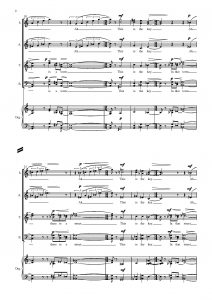
The Key to the Kingdom — Música de David Matthews — Texto anónimo © Copyright 2008 Faber Music Limited
Derechos reservados. Copyright internacional asegurado — Reproducido con autorización de Faber Music Limited
Lo que resalta el texto tan eficazmente es, en términos polifónicos, el uso de movimientos similares, paralelos y contrarios en las voces, claramente visibles en los compases 10, 11 y 12 respectivamente. Y con el empleo de pasajes de vocalización en “ah”, se consigue una cierta desincronización del texto. La obra fue encargada por Barbara Wakelyn y tuvo su primera presentación en 2007 en St Mary of Charity, Faversham, Reino Unido, por el Coro de Cámara de la Ciudad de Canterbury dirigido por George Vass.
Para evitar que los acusadores desahoguen su ira si un compositor que no sea Olivier Messiaen utilice el canto de los pájaros como inspiración, permítale al presente escritor apaciguar cualquier “situación” con respecto a otra obra de David Matthews, su Dawn Chorus. Como queda claro en el título, el compositor busca inspiración aquí en lo que la Humanidad presumiblemente siempre ha mirado con asombro, el sonido gradualmente acelerado y, a menudo, bastante tumultuoso de los miembros emplumados de la comunidad de aves que generalmente comienza mucho antes del amanecer. Pero la historia de la música está llena de ejemplos de obras basadas en sonidos y, en ocasiones, melodías claras ejecutadas por pájaros, desde Le chant des oiseaux de Clément Janequin hasta el Swan of Tuonela de Jean Sibelius (quien una vez comentó que el “llamado de la grulla” era el “leitmotiv” de su vida), por nombrar sólo dos.
En la obra de Matthews, compuesta para coro SATB con solistas a capella, es tentador ver los acordes extendidos tenuto –nótese que están marcados pp– en el coro como un paisaje imaginario, sobre el que se proyectan cantos de pájaros solistas, un técnica casi Ivesiana. Estas llamadas fragmentarias no son transcripciones exactas ‘a la Messiaen’, sino aproximaciones que utilizan tonos precisos, el objetivo del compositor es simplemente evocar cada especie particular en el oído de la mente. La primera soprano solista, tres compases después de la letra ‘C’ en la partitura, es un claro ejemplo, y hay que tener en cuenta las cuartas perfectas descendentes, que seguramente estarían más cerca de los tritonos en el entorno natural, así como las quintas perfectas ascendentes que encierran una quinta disminuida y una tercera mayor.
Armónicamente, el acorde de la letra “C” desafía un análisis interválico significativo y, por lo tanto, debe entenderse como no funcional. Lo que puede decirse, sin embargo, es que combina Mi menor y La mayor en algún tipo de relación tónica/dominante o tónica/subdominante. Para añadir un toque rítmico al canto de los pájaros, se utilizan acciaccaturas o trinos, por ejemplo seis compases después de “C”, que preceden a cada uno de los insistentes tipos de tono principal. Como podemos notar, algunas secciones en Dawn Chorus, si no son aleatorias, al menos permiten repeticiones de material ad libitum.
El tratamiento de la disonancia admite dos ámbitos diferenciados: local y global. Los cantos de los pájaros son esporádicos: apenas un solista ha emitido un llamado, el siguiente es audible, habiendo pocas posibilidades de percibir un estruendo o concordia; mientras que los acordes de ocho notas están tan atenuados que las fricciones internas específicas pueden escucharse a voluntad a lo largo de una línea de tiempo a medida que la partitura se realiza como sonido coral. Esta es, por supuesto, una respuesta mimética bastante directa al mundo sonoro natural, pero la polifonía debe entenderse no como los cantos de los pájaros in campo aperto, sino como su relación abstracta con las armonías de fondo casi estacionarias.
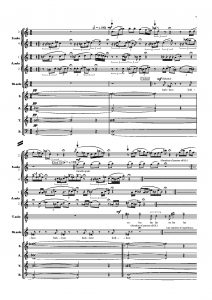
Dawn Chorus — Música de David Matthews — Texto: vocaliso © Copyright 2005 Faber Music Limited
Derechos reservados. Copyright internacional asegurado — Reproducido con autorización de Faber Music Limited
Para Dawn Chorus, Matthews grabó “muchos cantos durante la primavera, particularmente de mirlos y zorzales”, desde su casa en el norte de Londres, obteniendo “frases cantables”. Nueve solistas se encuentran repartidos por el espacio de actuación, su material vocal basado en los cantos de un zorzal común, curruca capirotada, carbonero común, mirlos, paloma torcaza, paloma de collar y finalmente un cucú. La canción del tordo comienza la pieza con un solo, y Matthews relata cómo “varias mañanas de mayo” constantemente “lo despertaban a las 4 am.” Como él mismo explica, al final de esta pequeña pieza impregnada de la sonoridad de la palabra natural, “todos los pájaros, antes del corte final, cantan juntos durante un minuto, para dejar un último sereno acorde del coro”. Estas son realmente muchas voces.
Richard Bratby, en la edición de mayo de 2018 de The Spectator, afirma que se trata de “cuatro minutos del arte que oculta el arte, en los que las voces humanas imitan el canto de los pájaros con una precisión alucinante”. La obra fue encargada por el Festival de Lichfield y el Consejo de las Artes de Inglaterra, y recibió su primera ejecución en 2015 por Ex Cathedra bajo la dirección de Jeffrey Skidmore en la Catedral de Lichfield.
Ecléctica es la mejor manera de describir la herencia y la educación musical de Alec Roth (*1948). Nacido cerca de Manchester, es de ascendencia germano/irlandesa y estudió música en la Universidad de Durham, dirección con Diego Masson y Rafael Kubelik, y gamelán en la Academia de Artes Escénicas de Indonesia en Surakarta, Java Central. Sus colaboraciones con el escritor indio Vikram Seth incluyen los ciclos de canciones Chinese Gardens (comisión del Festival de Chester 1998) y Romantic Residues (comisión del Festival de Bury St Edmunds 2003).
En Night Prayer (Te lucis ante terminum) para voces SSATBB a capella, Roth emplea el venerable himno ambrosiano del siglo VII para el cierre del día en Completas, un texto en el que se han inspirado tantos compositores, desde Thomas Tallis hasta Peter Maxwell Davies. Según Alec Roth, la versión de Tallis lo mantuvo “bajo su hechizo” desde que lo cantó por primera vez en su juventud, y agregó que su “melodía de canto llano ha sido una obsesión recurrente” y aparece en muchas de sus obras, “generalmente escondida bajo la superficie”. Un canto monofónico puede ser una bendición disfrazada: es notable cuán melódicamente elástico es, y permanece inmediatamente reconocible por más arcano que pueda ser cualquier tratamiento de cantus firmus; pero demostrará ser una bestia obstinada cuando se hagan intentos por desentrañar nuevas implicaciones armónicas. Suponiendo que uno adhiere a los Solesmes y no a la escuela mensural de interpretación del canto llano, Te lucis ante terminum ofrece en su tranquila belleza poco margen para el desarrollo rítmico. Roth resuelve estos problemas recurriendo –obviamente, podría uno argumentar- a su entrenamiento de gamelán. (Ocupó el cargo de Director Artístico del Programa Royal Festival Hall Gamelan 1987-91). En los compases 10-11 de Night Prayer, las polirritmias entre las voces superiores y las inferiores recuerdan fuertemente a la música de gamelán, demostrando ser motivos melódicos similares interpretados en diferentes tempos: en el compás 11, las cuatro corcheas con puntillo en 3/4 en sopranos y contraltos podrían, por supuesto, anotarse como un cuatrillo de corchea 4:3, quizás no con la misma eficacia en términos visuales. Los motivos son reconocibles y admiten una imitación estricta, incluso si ello roza la heterofonía simple, como en los compases 16-17 y 18-19. La práctica se invierte en el compás 25, con los valores puntillados en los tenores y bajos, y corcheas regulares en las dos voces de alto. En la interpretación se genera un fuerte sentido de actividad contrapuntística, pero permanece dentro de un marco armónico estrecho que limita deliberadamente con la stasis. Night Prayer fue un encargo de ORA100 para Suzi Digby y sus ORA Singers, quienes dieron la primera ejecución pública en Cutty Sark, Greenwich, en 2017.

Night Prayer — Música de Alec Roth — Texto latino & alemán anónimo, texto ingles de J. M. Neale © Copyright 2018 Peters Edition Ltd, London — Derechos reservados. Copyright internacional asegurado — Reproducido con autorización de Peters Edition Ltd
Es de esperar que la música de Judith Weir (*1954) no necesite una extensa introducción. Nacida de padres escoceses en Cambridge, Inglaterra, estudió composición con John Tavener, Robin Holloway y Gunther Schuller. A mediados de la década de 1990 se convirtió en compositora asociada de la Orquesta Sinfónica de la Ciudad de Birmingham, directora artística del Festival Spital fields y más tarde Profesora Invitada de las universidades de Princeton, Harvard y Cardiff. En 2014 Weir fue nombrada Maestra de la Música de la Reina, la primera mujer en ocupar el cargo. Es compositora de varias óperas, entre las que destacan A Night at the Chinese Opera (1987) y Blond Eckbert (1993). Su Two Human Hymns son un pilar de muchos coros en todo el mundo.
“Sing” de The Song Sung True, para coro SSAATBB a capella, es la primera de “cuatro canciones sobre cantar”. Está marcado como “directo y franco”. La obra es un legado de la difunta Helen Sibthorp, aparentemente una persona bastante directa y vivaz que hubiera deseado que cualquier monumento para ella fuera enérgico e inusual. Aunque Weir nunca la conoció personalmente, la compositora sintió que “el vínculo entre todos nosotros es la actividad vivificante del canto”, por lo que los cuatro movimientos de The Song Sung True son “sobre cantar y ponen un énfasis musical particular en las palabras ‘cantar’, ‘cantó’ y ‘canción’ ”.
Desde el principio, “Sing” demuestra ser inmensamente cantable. El tresillo en el compás 1 presentado como unísonos de octava se mueve de su nota final inmediatamente para formar segundas mayores, creando así un nivel de semidisonancia y un momento de micropolifonía. En el compás 2 se repite en una quinta perfecta más aguda, antes de caer a una tercera menor descendente. Este intervalo arquetípico se encuentra en las canciones infantiles de todo el mundo y es una especie de canto universal de “Ur-Song” que se encuentra en algún lugar entre el habla y la canción y que imita fuertemente los sonidos de la naturaleza, como el canto de los pájaros y las llamadas de los animales. A continuación se presenta una astuta variación motívica con contornos melódicamente gratificantes cuya conducción de voces es caracterizada, por ejemplo en sopranos y tenores en el compás 5 con el fuertemente evidente modo lidio moviéndose de Si’ a Do ’’ y de Si a Do’ respectivamente.
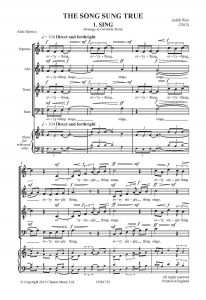
The Song Sung True — Música de Judith Weir — Texto de Alan Spence © Copyright 2013 Chester Music Limited
Derechos Reservados — Copyright internacional asegurado — Reproducido con autorización de Chester Music Limited
El texto simple de Alan Spence (*1947) -un escritor escocés que ha cruzado géneros y cubierto muchos temas, su producción a menudo se ubica en algún lugar entre la literatura y la filosofía, pero siempre está lleno de ideas del zen y la meditación contemplativa- está casado con la música sencilla, que no es menos eficaz gracias a los efectos imitativos que se encuentran en algún lugar entre el canon y la heterofonía; los compases 26-30 son un ejemplo de ello. El pintar las palabras en “tell the bell” con un nuevo motivo construido a partir de dos cuartas perfectas descendentes, produce un sonido coral resonante, cuasi-campanológico, siendo el conjunto mayor que la suma de sus cuatro partes simples. (Parece que Weir no es fanático de los divisi).
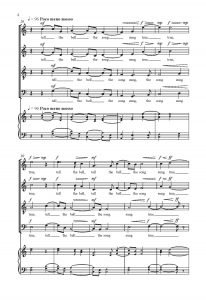
The Song Sung True — Música de Judith Weir — Texto de Alan Spence © Copyright 2013 Chester Music Limited
Derechos Reservados — Copyright internacional asegurado — Reproducido con autorización de Chester Music Limited
Claramente, entonces, no es sólo la disposición de voces en pares, sino también la urgencia de las entradas, primero a dos pulsos de distancia, y luego a uno solo, lo que crea una polifonía tan robusta. Esta es la obra de un contrapuntista seguro de sí mismo. El estreno del ciclo The Song Sung True fue en 2013 en St Lawrence Jewry, Londres, por el London Lawyers ’Chorus con Christopher Oakley.
La tercera parte del presente artículo es una discusión de la música coral de Francis Pott, Gabriel Jackson, Howard Moody, Roxanna Panufnik, Matthew Martin, Cheryl Frances-Hoad, Owain Park y Rhiannon Randle, con observaciones sobre la música de Thea Musgrave y Nico Muhly.
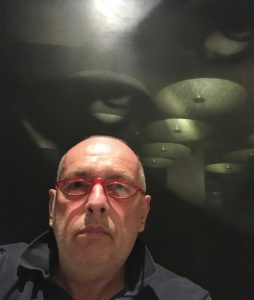 Graham Lack estudió composición y musicología en King’s College y Goldsmiths ‘ College en la Universidad de Londres, la Universidad de Chichester y la Universidad Técnica de Berlín. De 1982 a 1994 fue profesor de música en la Universidad de Maryland. Uno de sus más grandes aportes fue el Sanctus a 12 voces, encargado por el Queens’ College Cambridge en 1998, y transmitido en vivo por la radio alemana desde Colonia. Two Madrigals for High Summer (SSATB) se han representado en todo el mundo. En 2008 se estrenó en Londres REFUGIUM, basado en textos del poeta croata Peter Hektorović, para coro, órgano y tres percusionistas. Entre sus encargos tenemos Estraines para The King’s Singers, Lullabies para VOCES8, Demesnes para Quartonal, A Sphere of Ether para Young Voices of Colorado y Wondrous Machine para el multipercusionista Martin Grubinger. El trío de cuerdas The Pencil of Nature se estrenó en musicaviva en Munich. Las obras orquestales incluyen Nine Moons Dark y Five Inscapes. Los Preludios para piano solo, fueron estrenados por Lukáš Vondráček en el Queen Elizabeth Hall de Londres, y la obra orquestal Sitherwood por el Monteverdi Chor Würzburg. Actualmente está trabajando en un concierto para violín y orquesta titulado The Windhover para Benjamin Schmid. Lack es ganador del Concurso Internacional de Música Nueva Ortus de 2015. The Legend of Saint Wite (para SAA y cuarteto de cuerdas) ganó el premio BBC Music Magazine Competition en 2009. Grabó el CD Missa Dominica (Candelaria) en el mes de diciembre de 2017 y obtuvo el American Record Guide Critic’s Choice 2018 por su CD REFUGIUM. Desde 2018 es Compositor Fellow para el Trinity Boys Choir de Londres. graham-lack@t-online.de – www.graham-lack.com (photo © Astrid Ackerman)
Graham Lack estudió composición y musicología en King’s College y Goldsmiths ‘ College en la Universidad de Londres, la Universidad de Chichester y la Universidad Técnica de Berlín. De 1982 a 1994 fue profesor de música en la Universidad de Maryland. Uno de sus más grandes aportes fue el Sanctus a 12 voces, encargado por el Queens’ College Cambridge en 1998, y transmitido en vivo por la radio alemana desde Colonia. Two Madrigals for High Summer (SSATB) se han representado en todo el mundo. En 2008 se estrenó en Londres REFUGIUM, basado en textos del poeta croata Peter Hektorović, para coro, órgano y tres percusionistas. Entre sus encargos tenemos Estraines para The King’s Singers, Lullabies para VOCES8, Demesnes para Quartonal, A Sphere of Ether para Young Voices of Colorado y Wondrous Machine para el multipercusionista Martin Grubinger. El trío de cuerdas The Pencil of Nature se estrenó en musicaviva en Munich. Las obras orquestales incluyen Nine Moons Dark y Five Inscapes. Los Preludios para piano solo, fueron estrenados por Lukáš Vondráček en el Queen Elizabeth Hall de Londres, y la obra orquestal Sitherwood por el Monteverdi Chor Würzburg. Actualmente está trabajando en un concierto para violín y orquesta titulado The Windhover para Benjamin Schmid. Lack es ganador del Concurso Internacional de Música Nueva Ortus de 2015. The Legend of Saint Wite (para SAA y cuarteto de cuerdas) ganó el premio BBC Music Magazine Competition en 2009. Grabó el CD Missa Dominica (Candelaria) en el mes de diciembre de 2017 y obtuvo el American Record Guide Critic’s Choice 2018 por su CD REFUGIUM. Desde 2018 es Compositor Fellow para el Trinity Boys Choir de Londres. graham-lack@t-online.de – www.graham-lack.com (photo © Astrid Ackerman)
Traducido del inglés al español por Vania Romero, Venezuela
Revisado por Juan Casabellas, Argentina


